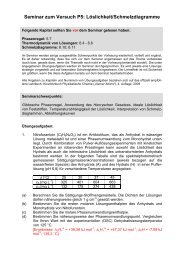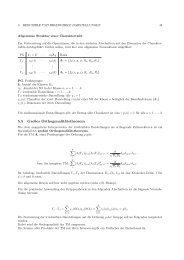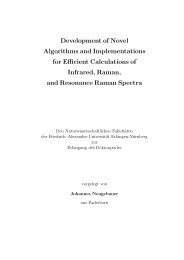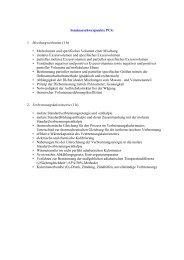Short documentation of the program (PDF)
Short documentation of the program (PDF)
Short documentation of the program (PDF)
Create successful ePaper yourself
Turn your PDF publications into a flip-book with our unique Google optimized e-Paper software.
Package Manual for gCP<br />
Version 1.04<br />
January 28, 2013<br />
1
1 Theory<br />
The central idea is to add in a semi-empirical fashion an energy correction ∆EgCP to <strong>the</strong> energies<br />
<strong>of</strong> molecular systems in order to remove artificial overbinding effects from BSSE. 1 As <strong>the</strong> focus lies<br />
on <strong>the</strong> contribution <strong>of</strong> individual atoms a natural outcome is its ability to yield also intramolecular<br />
BSSE corrections. The parametrization is constructed such that it approximates <strong>the</strong> Boys and<br />
Bernadi 2 counterpoise (CP) correction ∆ECP in <strong>the</strong> intermolecular case<br />
∆ECP ≈ ∆EgCP , (1)<br />
where e.g. for a complexation reaction A + B → C our correction is given by<br />
∆EgCP = EgCP (C) − EgCP (A) − EgCP (B) . (2)<br />
In practice, EgCP can simply be added to <strong>the</strong> HF/DFT energy<br />
The central equation over all atoms N reads:<br />
where <strong>the</strong> energy e miss<br />
a<br />
Etotal = E HF/DF T + EgCP . (3)<br />
EgCP = σ ·<br />
N∑<br />
a<br />
N∑<br />
b̸=a<br />
e miss<br />
a · fdec(Rab) , (4)<br />
is a measures for <strong>the</strong> incompleteness for <strong>the</strong> chosen target basis set (that<br />
is typically small), and fdec(Rab) is a decay function that depends on <strong>the</strong> inter-atomic distance<br />
Rab.<br />
The scaling factor σ is one out <strong>of</strong> 4 parameters needed for every / combination.<br />
Small basis sets show not only a large BSSE, but general shortcomings. These effects are not<br />
always clearly distinguishable. If computationally affordable, large basis sets (triple-ζ and higher)<br />
are always preferable for a given system.<br />
2 Quick Start<br />
Download <strong>the</strong> tarball from <strong>the</strong> homepage. 3 After unpacking <strong>the</strong> tarball, simply call make.<br />
The Intel compiler ifort and <strong>the</strong> GNU compiler gfortran are semi-automatically detected. If you<br />
prefer a different compiler edit <strong>the</strong> Makefile according to your liking. The code should (and must!)<br />
compile without any errors.<br />
The <strong>program</strong> can be invoked by typing<br />
gcp [-options]<br />
The coordinates can be given in Turbomole (unit = a.u.) or XMOL (unit = ˚A) format.<br />
3 Changelog<br />
V 1.04<br />
BUG : def2-SVP had wrong parameters for Li,Na,Mg,K. They have been updated. The old<br />
parameters set is available as svp old, eg. gcp coord -l hf/svp old<br />
added basis sets: sv(p) (=def2-SV(P)) and sv.x (def2-SV(P/h,c) which means no polarization<br />
fkts on H and C) eg: gcp coord -l ”dft/sv(p)” (<strong>the</strong> ” ” are important)<br />
2
added ecp-basis set: LANL2DZ for Sc-Zn to be combined with 6-31G(d)<br />
V 1.03 [added] HF/MINIX parametrization. (internal use only)<br />
V 1.02 [added] support for frozen cart. coordinates using Turbomole coordinates files.<br />
V 1.01 [BUG] fixed output in kcal/mol (showed kJ/mol)<br />
4 Program Options<br />
-level <br />
Choose one <strong>of</strong> <strong>the</strong> implemented / combinations. If not given, <strong>the</strong> <strong>program</strong><br />
expects a parameter file in <strong>the</strong> home directory ($HOME/.gcppar.$HOSTNAME, see below for fur<strong>the</strong>r<br />
information) The following combinations for are available:<br />
hf/minis dft/minis<br />
hf/minix dft/minix<br />
hf/sv dft/sv<br />
hf/svp dft/svp<br />
hf/svp_old dft/svp_old<br />
hf/631gd dft/631gd<br />
hf/tz dft/tz<br />
- dft/sv(p)<br />
- dft/svx<br />
- dft/lanl<br />
The basis sets are:<br />
minis: Huzinaga’s minimal basis set in <strong>the</strong> valence scaled version (EMSL: MINI(S)).<br />
minix: A modified Huzinaga’s minimal basis set. unpublished.<br />
sv: Ahlrichs’ split-valence double-ζ basis set SV.<br />
svp: Ahlrichs’ polarized split-valence double-ζ basis set def2-SVP.<br />
svp_old: Ahlrichs’ polarized split-valence double-ζ basis set def2-SVP. Slightly wrong parameters<br />
for Li, Na, Mg, K.<br />
tz: Ahlrichs polarized triple-ζ basis set def2-TZVP.<br />
631gd: Pople’s double-ζ basis set 6-31G* (or: 6-31G(d)) without polarization functions on H.<br />
sv(p): Ahlrichs def2-SV(P) basis set<br />
svx: Ahlrichs def2-SV(P/h,c) basis set:without polarization functions on H and C.<br />
lanl: 6-31G(d) on all main group elements and LANL2DZ on Sc-Zn.<br />
For <strong>the</strong> parametrization <strong>of</strong> dft <strong>the</strong> hybrid-functional B3-LYP was used, but <strong>the</strong> corrections will<br />
work with essentially any density functional, as <strong>the</strong> BSSE is ra<strong>the</strong>r insensible to <strong>the</strong> choice <strong>of</strong> <strong>the</strong><br />
functional.<br />
For dft/sv(p) is is necessary to care about <strong>the</strong> brackets on <strong>the</strong> unix command line: Ei<strong>the</strong>r as<br />
"dft/sv(p)" or dft/sv\(p\).<br />
-grad<br />
Calculates <strong>the</strong> gCP gradient. Will be automatically added to <strong>the</strong> Turbomole-file gradient if<br />
existent, o<strong>the</strong>rwise <strong>the</strong> gradient will be written to gcp_gradient.<br />
-h<br />
Prints an overview over all <strong>program</strong> options and o<strong>the</strong>r helpful information.<br />
-noprint<br />
Suppress printout.<br />
3
-parfile<br />
Produce an extended parameter file (see below).<br />
-local<br />
Read a parameter file from <strong>the</strong> local working directory.<br />
-hess<br />
Perform a numerical hessian calculation using analytical first derivatives. Prints out <strong>the</strong> resulting<br />
hessian matrix in Turbomole format in gcp_hessian.<br />
-test<br />
This will stop <strong>the</strong> <strong>program</strong> before calculating <strong>the</strong> energy/gradient, but after <strong>the</strong> parameter setup.<br />
This is useful if you want to check parameters, etc. before <strong>the</strong> actual run. Additionally, a check<br />
is performed if ’steric clashes’,i.e. distances below 0.7 ˚A are existent.<br />
-v<br />
Verbose output. Currently, this prints <strong>the</strong> gradient into <strong>the</strong> standard output (stdout, console).<br />
The file gcp_gradient is not written.<br />
4.1 Using parameter files<br />
Two kinds <strong>of</strong> parameter files can be read in: A short and an extended version. Both are read from<br />
$HOME/.gcppar.$HOSTNAME by default. If <strong>the</strong> option -local is specified <strong>the</strong> file is read in from<br />
<strong>the</strong> current working directory: .gcppar<br />
The short version reads in: basis-keyword sigma eta alpha beta e.g :<br />
sv 0.2 0.4 0.8 0.9<br />
The extended version can be generated by calling gcp -parfile -level .<br />
The file gcp.param is printed:<br />
# comment line<br />
sigma<br />
eta<br />
alpha<br />
beta<br />
nbas emiss (for all elements)<br />
This can <strong>the</strong>n be modified and read-in in <strong>the</strong> usual way. Note that # is a keyword used to identify<br />
<strong>the</strong> extended version <strong>of</strong> <strong>the</strong> parameter file. Therefore, one must not delete it.<br />
5 Example calls<br />
gcp coord -level hf/minis<br />
This will do a gCP correction for a HF/MINIS calculation using <strong>the</strong> coordinates from <strong>the</strong> file<br />
coord.<br />
gcp water.xyz -level dft/631gd -grad -noprint<br />
This can be used to calculate <strong>the</strong> gCP correction for a B3-LYP/6-31G* calculation, using coordinates<br />
from <strong>the</strong> file water. It will also calculate <strong>the</strong> gradient, and add it to <strong>the</strong> file gradient (a<br />
Turbomole file), if existent. O<strong>the</strong>rwise, <strong>the</strong> gradient will be written to gcp_gradient.<br />
4
References<br />
[1] Kruse, H.; Grimme, S. J. Chem. Phys. 2012, 136, 154101.<br />
[2] Boys, S. F.; Bernardi, F. Mol. Phys. 1970, 19, 553–566.<br />
[3] See website by <strong>the</strong> group <strong>of</strong> Pr<strong>of</strong>. Stefan Grimme: http://www.thch.uni-bonn.de/tc/.<br />
5







